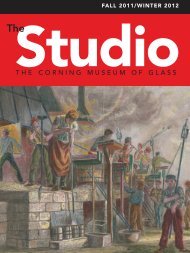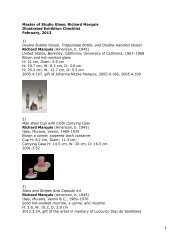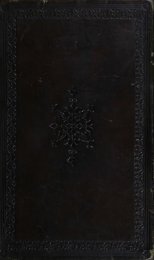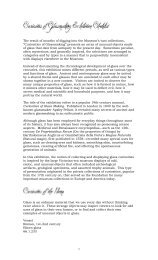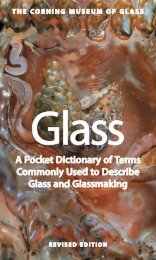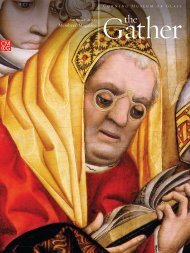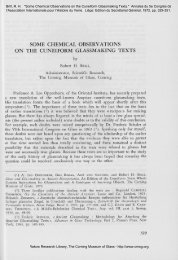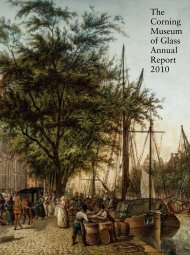english cameo glass in the corning museum of glass
english cameo glass in the corning museum of glass
english cameo glass in the corning museum of glass
You also want an ePaper? Increase the reach of your titles
YUMPU automatically turns print PDFs into web optimized ePapers that Google loves.
This k<strong>in</strong>d <strong>of</strong> <strong>glass</strong> sculpture is yet <strong>in</strong> its <strong>in</strong>fancy<br />
but no doubt it will mature <strong>in</strong>to great<br />
th<strong>in</strong>gs. It is capable <strong>of</strong> very superior f<strong>in</strong>ish—<br />
a f<strong>in</strong>ish not to be atta<strong>in</strong>ed even upon <strong>the</strong><br />
f<strong>in</strong>est porcela<strong>in</strong> and is remarkable, not only<br />
for <strong>the</strong> sharpness <strong>of</strong> <strong>the</strong> outl<strong>in</strong>es which are<br />
obta<strong>in</strong>ed but also for what artists term <strong>the</strong><br />
f<strong>in</strong>e texture <strong>of</strong> <strong>the</strong> figure work.<br />
Anon., Birm<strong>in</strong>gham Daily Gazette,<br />
April 11, 1878<br />
JOHN NORTHWOOD (1836-1902) dom<strong>in</strong>ated<br />
<strong>the</strong> early years <strong>of</strong> English <strong>cameo</strong> <strong>glass</strong> mak<strong>in</strong>g.<br />
Born <strong>in</strong> Wordsley, he jo<strong>in</strong>ed W. H., B. 6c J.<br />
Richardson about 1848, and here he learned <strong>the</strong><br />
techniques <strong>of</strong> pa<strong>in</strong>t<strong>in</strong>g, enamel<strong>in</strong>g, and gild<strong>in</strong>g.<br />
He left Richardson's <strong>in</strong> 1852 and worked for his<br />
elder bro<strong>the</strong>r until Benjam<strong>in</strong> Richardson took<br />
over <strong>the</strong> old works and re-engaged him. John<br />
Northwood was employed by Richardson until<br />
1859, when he left to form a partnership with his<br />
bro<strong>the</strong>r Joseph, Henry Geth<strong>in</strong>g Richardson, and<br />
Thomas Guest. The new partnership was dissolved<br />
<strong>in</strong> 1860, when John and Joseph established<br />
a f<strong>in</strong>ish<strong>in</strong>g shop known as J. 8c J. Northwood.<br />
Joseph was <strong>the</strong> manager, and John concentrated<br />
on develop<strong>in</strong>g new decorat<strong>in</strong>g techniques.<br />
In 1861, John <strong>in</strong>troduced <strong>the</strong> Template<br />
Etch<strong>in</strong>g Mach<strong>in</strong>e, which produced decoration<br />
mechanically by trac<strong>in</strong>g designs <strong>in</strong> <strong>the</strong> wax-coated<br />
<strong>glass</strong> through wooden templates. He also<br />
<strong>in</strong>vented <strong>the</strong> Geometrical Etch<strong>in</strong>g Mach<strong>in</strong>e<br />
(1865), which operated without templates, and<br />
he capped <strong>the</strong>se achievements by develop<strong>in</strong>g<br />
"white acid" (hydr<strong>of</strong>luoric acid and potassium<br />
carbonate or sodium carbonate). This dissolved<br />
<strong>the</strong> surface <strong>of</strong> <strong>glass</strong> without eat<strong>in</strong>g <strong>in</strong>to it, <strong>the</strong>reby<br />
enabl<strong>in</strong>g him to decorate a <strong>cameo</strong> <strong>glass</strong> object<br />
from start to f<strong>in</strong>ish by etch<strong>in</strong>g alone. These <strong>in</strong>ventions<br />
permitted <strong>the</strong> Northwoods to become<br />
<strong>the</strong> largest producers <strong>of</strong> etched <strong>glass</strong> <strong>in</strong> Stourbridge,<br />
employ<strong>in</strong>g between 50 and 60 f<strong>in</strong>ishers.<br />
At <strong>the</strong> same time, John Northwood established<br />
his own reputation as an outstand<strong>in</strong>g carver<br />
and engraver <strong>of</strong> <strong>glass</strong>. His Elg<strong>in</strong> Vase, com-<br />
THE EARLY YEARS<br />
missioned <strong>in</strong> 1864 and completed <strong>in</strong> 1873, is a<br />
colorless <strong>glass</strong> amphora carved with a frieze <strong>of</strong><br />
horses and riders based on <strong>the</strong> Elg<strong>in</strong> Marbles <strong>in</strong><br />
<strong>the</strong> British Museum. Hailed as a masterpiece, <strong>the</strong><br />
Elg<strong>in</strong> Vase was <strong>the</strong> forerunner <strong>of</strong> <strong>the</strong> English<br />
"Rock Crystal" style <strong>of</strong> deeply cut, engraved,<br />
and polished <strong>glass</strong>, which helped to establish<br />
Stourbridge as <strong>the</strong> center <strong>of</strong> <strong>the</strong> English f<strong>in</strong>e <strong>glass</strong><br />
<strong>in</strong>dustry.<br />
In <strong>the</strong> 1860s and 1870s, J. 8c J. Northwood<br />
produced some <strong>of</strong> <strong>the</strong> best acid-etched <strong>glass</strong> <strong>in</strong><br />
<strong>the</strong> Stourbridge region, and when <strong>cameo</strong> <strong>glass</strong><br />
became popular, Northwood's became <strong>the</strong> f<strong>in</strong>ish<strong>in</strong>g<br />
shop for Stevens 8c Williams.<br />
Despite <strong>the</strong> efficiency <strong>of</strong> John Northwood's<br />
etch<strong>in</strong>g mach<strong>in</strong>es, <strong>the</strong> f<strong>in</strong>est <strong>cameo</strong> <strong>glass</strong> was f<strong>in</strong>ished<br />
by hand. In 1873, Philip Pargeter (1826-<br />
1906), proprietor <strong>of</strong> <strong>the</strong> Red House Glass<br />
Works, told Northwood, "I believe I can make<br />
<strong>the</strong> Portland Vase if you can decorate it." 5<br />
Pargeter's challenge echoed a sentiment expressed<br />
26 years previously by Apsley Pellatt <strong>of</strong><br />
<strong>the</strong> Falcon Glass Works, London. At a meet<strong>in</strong>g<br />
<strong>of</strong> <strong>the</strong> Royal Institution on February 12, 1847,<br />
Pellatt exhibited a cased blank <strong>of</strong> <strong>the</strong> same shape<br />
and size as <strong>the</strong> orig<strong>in</strong>al Portland Vase, "declar<strong>in</strong>g<br />
that if any British engraver, <strong>of</strong> adequate skill,<br />
should propose to make an exact copy <strong>in</strong> <strong>glass</strong> ...<br />
his firm would undertake <strong>the</strong> manufacture <strong>of</strong> <strong>the</strong><br />
vessel." 6<br />
Northwood accepted <strong>the</strong> challenge. The<br />
blank was blown at <strong>the</strong> Red House Glass Works<br />
by Daniel Hancox, assisted by Joseph Worrall,<br />
Charles Hancox (Daniel's son), and Benjam<strong>in</strong><br />
Down<strong>in</strong>g. It was entrusted to John Northwood,<br />
who spent three years carv<strong>in</strong>g it. The project<br />
almost foundered when, at an advanced stage,<br />
<strong>the</strong> vase cracked as a result <strong>of</strong> <strong>the</strong>rmal shock<br />
when warm hands picked up <strong>the</strong> cold <strong>glass</strong>.<br />
Fortunately, <strong>the</strong> crack was repaired with an adhesive,<br />
and Northwood completed his task.<br />
In his rem<strong>in</strong>iscences, Thomas Woodall,<br />
who later became a member <strong>of</strong> <strong>the</strong> celebrated<br />
Woodall Team at Thomas Webb 8c Sons, recalled<br />
assist<strong>in</strong>g Northwood <strong>in</strong> decorat<strong>in</strong>g <strong>the</strong><br />
vase: "I made <strong>the</strong> first draw<strong>in</strong>gs and pa<strong>in</strong>ted



